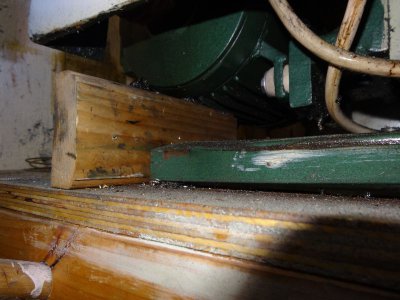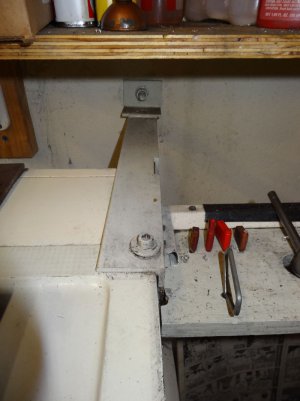- Joined
- Jun 23, 2011
- Messages
- 786
At one point I mentioned parenthetically that my G4003 headstock was braced to the wall of my shop and a quick and dirty motor mod that improved SF. I was asked in a PM to provide pictures. So here's some pics with a brief write-up.
First the motor mod. A single phase motor inherently vibrates at some multiple of the mains frequency. This vibration can be felt all over the lathe and shows up in the SF. So, the first and most obvious fix would be to mount the motor on isolators which I did. It made things better but did not eradicate the issue. I found that loosening the belt tensioning bolts so the motor can float a bit, then supporting the motor from underneath would allow said vibrations to go into the stand rather than the lathe itself. So, I just cut a 2x4 about 8" long and sanded a small taper on it. By driving like a wedge between the lathe and the stand, I found a sweet spot where vibration almost completely went away.
Here's a photo of the isolators and the wood:

Next, I wanted to improve the rigidity of the headstock by bracing it to the wall. This was the most bang for the buck. Since the back edge of my lathe stand is tied to the concrete wall of my shop, this works for me. If your stand is not tied to the wall, or your walls aren't concrete, you're likely to make things worse by doing this... My lathe stand is multiple layers of plywood with a metal and wood subframe. I could park a tractor on it!
The photos will say it all. The groove in the right side of the brace allows the cover on the electrical box to open.

John


First the motor mod. A single phase motor inherently vibrates at some multiple of the mains frequency. This vibration can be felt all over the lathe and shows up in the SF. So, the first and most obvious fix would be to mount the motor on isolators which I did. It made things better but did not eradicate the issue. I found that loosening the belt tensioning bolts so the motor can float a bit, then supporting the motor from underneath would allow said vibrations to go into the stand rather than the lathe itself. So, I just cut a 2x4 about 8" long and sanded a small taper on it. By driving like a wedge between the lathe and the stand, I found a sweet spot where vibration almost completely went away.
Here's a photo of the isolators and the wood:

Next, I wanted to improve the rigidity of the headstock by bracing it to the wall. This was the most bang for the buck. Since the back edge of my lathe stand is tied to the concrete wall of my shop, this works for me. If your stand is not tied to the wall, or your walls aren't concrete, you're likely to make things worse by doing this... My lathe stand is multiple layers of plywood with a metal and wood subframe. I could park a tractor on it!
The photos will say it all. The groove in the right side of the brace allows the cover on the electrical box to open.

John



